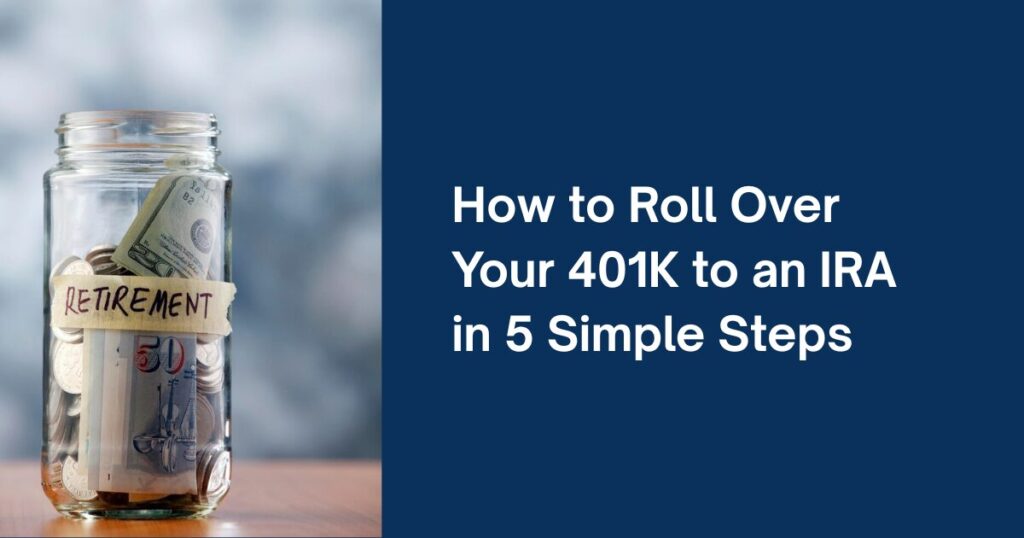
Introduction
Here’s something most people don’t realize: leaving your old 401K behind when you switch jobs could cost you thousands in hidden fees and missed growth opportunities. Nearly 25 million forgotten 401K accounts hold over $1.35 trillion in retirement savings, according to recent data from Capitalize.
When you change employers or retire, you’re left with a critical decision: what should you do with that 401K? Rolling it over to an Individual Retirement Account (IRA) often makes the most financial sense, but the process can feel overwhelming if you’ve never done it before.
This guide walks you through everything you need to know about 401K to IRA rollovers. You’ll learn the exact steps to move your money without triggering taxes or penalties, understand which rollover option fits your situation, and discover how to avoid the most common mistakes that trip up even experienced investors.
What is a 401K rollover to IRA?
A 401K rollover to IRA is the process of transferring retirement funds from your employer-sponsored 401K plan into an Individual Retirement Account. This allows you to maintain tax-advantaged status while gaining more investment control, lower fees, and consolidated retirement savings. Direct rollovers avoid taxes and penalties when done correctly.
What Is a 401K to IRA Rollover and Why Consider It?
A 401K rollover means moving your retirement savings from your employer’s plan into an IRA that you control directly. Think of it as changing the container that holds your retirement money, not withdrawing or spending it.
The mechanics are straightforward: your 401K administrator sends your account balance either directly to your new IRA custodian or issues you a check to deposit within 60 days. The key difference lies in how the money moves, which dramatically affects your tax situation.
Most people consider rollovers when they leave a job, retire, or want better investment options. Your old 401K might charge high administrative fees, offer limited investment choices, or simply become harder to track once you’re no longer with that employer. An IRA typically provides thousands of investment options compared to the 10-20 funds in most 401K plans. You’ll also consolidate multiple old retirement accounts into one place, making it easier to manage your overall retirement strategy and rebalance your portfolio.
The decision isn’t always black and white, though. Some 401K plans offer institutional-grade funds with expense ratios lower than what you’d find in an IRA. If your former employer’s plan has exceptionally low fees and solid investment options, keeping it there might make sense.
Understanding Your 401K Rollover Options
You’ve got four main paths when deciding what to do with your old 401K. Each option carries different tax implications and fits different financial situations.
Option 1: Direct Rollover to IRA
This is the cleanest route. Your 401K administrator sends the funds directly to your IRA custodian. You never touch the money, which means no taxes withheld and no risk of missing the 60-day deadline. This works for both traditional 401Ks rolling to traditional IRAs and Roth 401Ks rolling to Roth IRAs.
Option 2: Indirect Rollover
The plan administrator cuts you a check for your account balance minus 20% mandatory withholding. You must deposit the full amount (including that 20% from your own pocket) into an IRA within 60 days. Miss that deadline, and the entire amount becomes taxable income plus a 10% early withdrawal penalty if you’re under 59½. The IRS returns the 20% withholding when you file taxes, assuming you completed the rollover correctly.
Option 3: Leave It in Your Old 401K
If your account balance exceeds $7,000, most employers let you keep your money in their plan indefinitely. This makes sense if you’re between ages 55 and 59½ and might need early access (401Ks allow penalty-free withdrawals at 55 if you leave your job, while IRAs make you wait until 59½).
Option 4: Roll Into Your New Employer’s 401K
If your new job offers a 401K with strong investment options and low fees, you can consolidate everything there. This keeps your retirement savings in one place and maintains certain legal protections that 401Ks have over IRAs.
The direct rollover wins for most people because it’s simple, safe, and tax-free. The indirect route adds unnecessary complexity and risk. Your specific situation might call for keeping the old 401K or rolling into a new one, but those scenarios are less common.
People Also Love to Read This: What’s the Real Cost of a Business Line of Credit ?
The 5-Step Process to Roll Over Your 401K to an IRA
Let’s walk through exactly how to execute a direct rollover without mistakes.
Step 1: Open Your IRA
Choose a custodian that matches your investing style. Vanguard, Fidelity, and Schwab offer low-cost index funds and no account fees. If you want more hands-on investing, consider brokers like E*TRADE or TD Ameritrade. Robo-advisors like Betterment work if you prefer automated management. Open either a traditional IRA (for traditional 401K money) or Roth IRA (for Roth 401K funds). The account setup takes 10-15 minutes online.
Step 2: Contact Your 401K Administrator
Call the benefits department at your old employer or the 401K plan administrator directly. Request a “direct rollover distribution” and specify you want the check made payable to your new IRA custodian for your benefit. For example: “Vanguard FBO [Your Name].” Get clear instructions on required paperwork and timelines.
Step 3: Complete the Rollover Request Forms
Both your 401K plan and your new IRA custodian will have forms. The 401K side asks where to send the money. The IRA side confirms they’re receiving a rollover contribution. Double-check account numbers and names match perfectly. Any discrepancy can delay the transfer by weeks.
Step 4: Choose Direct Transfer
Never request a check made payable to you personally. Always select the direct trustee-to-trustee transfer option. If for some reason you must receive a check, ensure it’s made out to your IRA custodian, not to you. This avoids the 20% mandatory withholding and the 60-day deadline stress.
Step 5: Confirm Receipt and Invest
The transfer typically takes 2-4 weeks. Your old 401K will show the distribution, and your IRA will show the contribution. Once the funds hit your IRA, they sit in a money market fund or settlement account until you invest them. Don’t let them sit idle, pick your investments right away to keep your money working for you.
Traditional vs. Roth 401K Rollover: Tax Considerations
The tax treatment of your rollover depends on what type of accounts you’re moving between. Get this wrong, and you could face an unexpected tax bill.
Rolling a traditional 401K to a traditional IRA is tax-neutral. Both accounts use pre-tax dollars, so no taxes trigger. You maintain the same tax-deferred status and pay ordinary income tax when you eventually withdraw the money in retirement.
Rolling a Roth 401K to a Roth IRA is also tax-free. You already paid taxes on these contributions, so moving between Roth accounts doesn’t create any new tax liability. The five-year clock for qualified withdrawals continues from when you first contributed to any Roth account.
Here’s where it gets tricky: converting a traditional 401K to a Roth IRA. This move triggers income taxes on the entire rollover amount in the year you do it. You’re essentially paying taxes now instead of later. This strategy makes sense if you’re currently in a low tax bracket, expect higher taxes in retirement, or want tax-free growth going forward. Just make sure you have cash outside the retirement account to pay the tax bill. Never use retirement funds to pay conversion taxes.
Some 401Ks hold both pre-tax and Roth contributions. You’ll split the rollover, sending traditional money to a traditional IRA and Roth money to a Roth IRA. The plan administrator can help you separate these correctly.
Common Rollover Mistakes and How to Avoid Them
Even straightforward rollovers can go sideways if you’re not careful. Here are the traps that catch most people.
Missing the 60-day deadline with indirect rollovers. Life happens. You receive the check, put it aside, and suddenly 65 days have passed. Now the entire amount is taxable income. Unless you qualify for a hardship waiver (serious illness, natural disaster, postal error), you’re stuck paying taxes and potentially a 10% penalty. Solution: always choose direct rollovers.
Forgetting the 20% withholding rule. With indirect rollovers, the IRS requires 20% withholding. If your 401K holds $50,000, you’ll receive a check for $40,000. To avoid taxes, you must deposit the full $50,000 into your IRA within 60 days, coming up with that extra $10,000 from other funds. Many people miss this and only deposit the $40,000 they received, making that $10,000 taxable. Solution: direct rollover, or have cash ready.
Mixing up traditional and Roth accounts. Rolling traditional 401K money into a Roth IRA without realizing it’s a taxable conversion is an expensive mistake. Always match account types unless you specifically intend to do a Roth conversion. Solution: clearly label everything and confirm account types before submitting paperwork.
Cashing out instead of rolling over. Taking a lump-sum distribution feels tempting, especially for smaller balances. But you’ll lose 20% to immediate withholding, pay income tax on the full amount, and potentially face a 10% early withdrawal penalty. A $30,000 balance could shrink to $18,000 after all deductions. Solution: always roll over, never cash out.
Rolling over employer stock without considering NUA. If your 401K includes company stock that has appreciated significantly, you might benefit from Net Unrealized Appreciation (NUA) treatment instead of a rollover. This advanced strategy lets you pay capital gains tax instead of ordinary income tax on the appreciation. Solution: consult a tax professional before rolling over company stock.
Is a 401K to IRA Rollover Right for You?
Not everyone should roll over their 401K. Here’s how to decide if it makes sense for your situation.
Rollover makes sense when:
- You want more investment choices beyond your 401K’s limited menu
- Your old 401K charges high administrative or management fees
- You’re consolidating multiple old retirement accounts for simpler management
- You’ve left your employer and don’t plan to return
- You want to implement more sophisticated tax planning strategies
- You prefer working with a specific financial advisor who can’t manage 401K accounts
Keep your 401K when:
- You’re age 55-59½ and might need penalty-free early access
- Your 401K offers institutional funds with rock-bottom expense ratios
- Your plan includes stable value funds not available in IRAs
- You work in a profession with high liability exposure (401Ks have stronger creditor protection than IRAs in some states)
- You’re planning to retire early and want to use the Rule of 55
The financial impact adds up over decades. A $100,000 401K charging 1% in fees versus an IRA charging 0.10% means you’ll pay about $30,000 less in fees over 30 years, resulting in an extra $60,000+ in your account due to compound growth on those saved fees.
People Also Love to Read This: Credit Score Monitoring Tools: Best Options & Features
Conclusion
Rolling over your 401K to an IRA puts you in control of your retirement future. You’ll access better investment options, potentially lower fees, and simplified account management while keeping the same tax advantages you had before.
The process itself takes just a few weeks when you follow the direct rollover method. Contact your old 401K administrator, open an IRA with a low-cost provider, request a direct trustee-to-trustee transfer, and invest your funds once they arrive. Skip the indirect rollover entirely to avoid the 20% withholding hassle and 60-day deadline stress.
Your specific situation might call for keeping your old 401K or rolling into a new employer’s plan, but for most people, a 401K rollover to IRA is the smart move. Take action now rather than letting that old account sit forgotten and costing you money in unnecessary fees.
FAQs About 401K to IRA Rollovers
How long does a 401K to IRA rollover take?
Most direct rollovers complete within 2-4 weeks from when you submit all required paperwork. The timeline varies by plan administrator. Some process requests within a few days, while others take up to 6 weeks during busy periods. You can speed things up by submitting complete, accurate forms the first time and following up with both your old 401K provider and new IRA custodian to confirm they’ve received everything they need.
Can I roll over my 401K to an IRA while still employed?
Generally no, most employers don’t allow in-service rollovers until you reach age 59½. Some plans permit it earlier for after-tax contributions or if you’ve been in the plan for at least two years, but these rules vary by employer. Once you leave your job or retire, you can roll over your 401K anytime. Check your specific plan’s Summary Plan Description or contact HR to understand your company’s rules.
Will I pay taxes on a 401K to IRA rollover?
No taxes apply when you do a direct rollover between matching account types (traditional to traditional or Roth to Roth). The IRS treats this as a non-taxable transfer. However, converting a traditional 401K to a Roth IRA is taxable because you’re moving pre-tax money into an after-tax account. Indirect rollovers face 20% mandatory withholding, which you get back as a tax refund if you complete the rollover within 60 days. Always choose direct rollovers to avoid tax complications.



